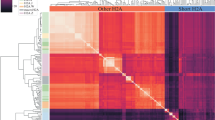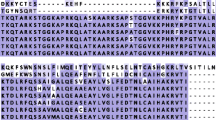Summary
Protein-specific versus taxon-specific patterns of nucleotide frequencies were studied in histone genes. The third positions of codons have a (well-known) taxon-specific G+C level and a histone type-specific G/C ratio. This ratio counterbalances the G/C ratio in the first and second positions so that the overall G and C levels in the coding region become approximately equal. The compensation of the G/C ratio indicates a selection pressure at the mRNA level rather than a selection pressure or mutation bias at the DNA level or a selection pressure on codon usage. The structure of histone mRNAs is compatible with the hypothesis that the G/C compensation is due to selection pressures on mRNA secondary structure. Nevertheless, no specific motifs seem to have been selected, and the free energy of the secondary structures is only slightly lower than that expected on the basis of nucleotide frequencies.
Similar content being viewed by others
References
Albrecht G, Krowczynska A, Brawerman G (1984) Configuration of β-globin messenger RNA in rabbit reticulocytes. J Mol Biol 178:881–896
Aziz N, Munro HN (1987) Iron regulates ferritin mRNA translation through a segment of its 5′ untranslated region. Proc Natl Acad Sci USA 84:8478–8482
Bernardi G, Bernardi G (1985) Codon usage and genome composition. J Mol Evol 22:363–365
Bernardi G, Bernardi G (1986) Compositional constraints and genome evolution. J Mol Evol 24:1–11
Bernardi G, Olofsson B, Filipski J, Zerial M, Salinas J, Cuny G, Meunier-Rotival M, Rodier F (1985) The mosaic genome of warm-blooded vertebrates. Science 228:953–958
Bernardi G, Mouchiroud D, Gautier C, Bernardi G (1988) Compositional patterns in vertebrate genomes: conservation and change in evolution. J Mol Evol 28:7–18
Birchmeier C, Folk W, Birnstiel M (1983) The terminal RNA stem-loop structure and 80 by of spacer DNA are required for the formation of 3′ termini of sea urchin H2A mRNA. Cell 35:433–440
Bird AP (1980) DNA methylation and the frequency of CpG in animal DNA. Nucleic Acids Res 8:1499–1504
Blaisdell BE (1983) Choice of base at silent codon site 3 is not selectively neutral in eukaryotic structural genes: it maintains excess short runs of weak and strong hydrogen bonding bases. J Mol Evol 19:226–236
Blake RD, Hinds PW (1984) Analysis of the codon bias in E. coli sequences. J Biomol Struct Dyn 2:593–606
Bohr VA, Smith CA, Okumoto DS, Hanawalt PC (1985) DNA repair in an active gene: removal of pyrimidine dimers from the DHFR gene of CHO cells is much more efficient than in the genome overall. Cell 40:359–369
Brawerman G (1990) Mechanisms of mRNA decay. Trends Biotechnol 87:171–174
Bulmer M (1989) Codon usage and secondary structure of MS2 phage RNA. Nucleic Acids Res 17:1839–1843
Chargaff E, Davidson JN (1955) The nucleic acids. Academic Press, New York
Coulondre C, Miller JH, Farabough PJ, Gilbert W (1978) Molecular basis of base substitution hotspots in Escherichia coli. Nature 274:775–780
Edery I, Petryshyn R, Sononberg N (1989) Activation of double stranded RNA dependent kinase (dsl) by the TAR region of HIV-1 mRNA: a novel translational control mechanism. Cell 56:303–312
Filipski J (1987) Correlation between molecular clock ticking, codon usage, fidelity of DNA repair, chromosome banding and chromatin compactness in germline cells. FEBS Lett 217: 184–186
Fitch WM (1974) The large extent of putative secondary nucleic acid structure in random nucleotide sequences or amino acid derived messenger RNA. J Mol Evol 3:279–291
Fontana W, Schuster W (1987) A computer model for evolutionary optimization. Biophys Chem 26:123–147
Graves RA, Pandey NB, Chodchoy N, Marzluff W (1987) Translation is required for regulation of histone mRNA degradation. Cell 48:615–626
Hanai R, Wada A (1988) The effects of guanine and cytosine variation on dinucleotide frequency and amino acid composition in the human genome. J Mol Evol 27:321–325
Hargrove JL, Schmidt FH (1989) The role of mRNA and protein stability in gene expression. FASEB J 3:2360–2370
Hasegawa M, Yasunaga T, Miyata T (1979) Secondary structure of MS2 phage RNA and bias in code word usage. Nucleic Acids Res 7:2073–2079
Hénaut A, Limaiem J, Vigier P (1985) The origins of the strategy of codon use. Biochimie (Paris) 67:475–483
Ikemura T (1985) Codon usage and tRNA content in unicellular and multicellular organisms. Mol Biol Evol 2:13–34
Jeffrey HJ (1990) Chaos game representation of gene structure. Nucleic Acids Res 18:2163–2170
Konings DAM, Duijn LP van, Voorma HO, Hogeweg P (1987) Minimal energy foldings of eukaryotic mRNAs form a separate leader domain. J Theor Biol 127:63–78
Konopka K, Brendel V (1985) The missense errors in protein can be controlled by selective synonymous codon usage at the level of transcription. Biochimie (Paris) 67:469–473
Kruskal WH, Wallis WA (1952) Use of ranks in one-criterion variance analysis. J Am Stat Assoc 47:583–621
Le S-Y, Chen J-H, Maizel JV (1990) Efficient searches for unusual folding regions in RNA sequences. In: Sarma RH, Sarma MH (eds) Proceedings 6th conversation in biomolecular stereodynamics. Adenin Press, New York, 1:127–136
Marzluff WF, Graves RA (1984) Organization and expression of mouse histone genes. In: Stein G, Stein J, Marzluff W (eds) Histone genes: structure, organization and regulation. John Wiley and Sons, New York, pp 281–315
Mita M, Sachiko I, Misuo Z, Tharappel CJ (1988) Specific codon usage pattern and its implications on the secondary structure of silk fibroin mRNA. J Mol Biol 203:917–925
Modiano G, Battistuzi G, Motulsky AG (1981) Nonrandom patterns of codon usage and of nucleotide substitutions in human α- and β-globin genes: an evolutionary strategy reducing the rate of mutations with drastic effects? Proc Natl Acad Sci USA 78:1110–1114
Muesing M, Smith D, Capon D (1987) Regulation of mRNA accumulation by a human immunodeficiency virus trans-activator protein. Cell 48:691–701
Nussinov R (1981) Eukaryotic dinucleotide preference rules and their implications for degenerate codon usage. J Mol Biol 149:125–131
Ohno S (1987) Evolution from primordial oligomeric repeats to modern coding sequences. J Mol Evol 25:325–329
Ohno S (1988) Universal rule for coding sequence construction: TA/CG deficiency-TG/CT excess. Proc Natl Acad Sci USA 85:9630–9634
Perrin P, Bernardi G (1987) Directional fixation of mutations in vertebrate evolution. J Mol Evol 26:301–310
Salinas J, Matassi G, Montero L, Bernardi G (1988) Compositional compartmentalization and compositional patterns in the nuclear genomes of plants. Nucleic Acids Res 16:4269–4295
Salser W (1977) Globin mRNA sequences: analysis of base pairing and evolutionary implications. Cold Spring Harbor Symp Quant Biol 42:987–1104
Shapiro DJ, Blume JE, Nielsen DA (1987) Regulation of messenger RNA stability in eukaryotic cells. BioEssays 6:221–226
Shaw G, Kamen R (1986) A conserved AU sequence from the 3′ untranslated region of GM-CSF mRNA mediates selective mRNA degradation. Cell 46:659–667
Sittman DB, Graves RA, Marzluff WA (1983) Histone mRNA concentrations are regulated at the level of transcription and mRNA degradation. Proc Natl Acad Sci USA 80:1849–1853
Stauber C, Lüscher B, Eckner R, Lötscher E, Schümperli D (1986) A signal regulating mouse histone H4 mRNA levels in a mammalian cell cycle mutant and sequences controlling RNA 3′ processing are both contained within the same 80-bp fragment. EMBO J 5:3297–3303
Tönjes R, Munk K, Doenecke D (1989) Conserved organization of an avian histone gene cluster with inverted duplications of H3 and H4 genes. J Mol Evol 28:200–211
Wada A, Suyama A (1986) Local stability of DNA and RNA secondary structure and its relation to biological functions. Prog Biophys Mol Biol 47:113–157
Wells D, Herrman J (1989) Functionally constrained codon usage in histone genes. Int J Biochem 21:1–6
Wells D, Bains W, Kedes L (1986) Codon usage in histone gene families of higher eukaryotes reflects functional rather than phylogenetic relationships. J Mol Evol 23:224–241
Wilcoxon F (1945) Individual comparisons by ranking methods. Biometrics Bull 1:80–83
Wilhelm ML, Wilhelm FX (1989) Histone genes in Physarum polycephalum: transcription and analysis of the flanking regions of the two H4 genes. J Mol Evol 28:322–326
Zama M (1990) Codon usage pattern in a2 (I) chain domain of chicken type I collagen and its implications for the secondary structure of the mRNA and the synthesis pauses of the collagen. Biochem Biophys Res Commun 167:772–776
Zuker M (1989) On finding all suboptimal foldings of an RNA molecule. Science 244:48–52
Author information
Authors and Affiliations
Additional information
Offprint requests to: M. A. Huynen
Rights and permissions
About this article
Cite this article
Huynen, M.A., Konings, D.A.M. & Hogeweg, P. Equal G and C contents in histone genes indicate selection pressures on mRNA secondary structure. J Mol Evol 34, 280–291 (1992). https://doi.org/10.1007/BF00160235
Received:
Accepted:
Issue Date:
DOI: https://doi.org/10.1007/BF00160235




